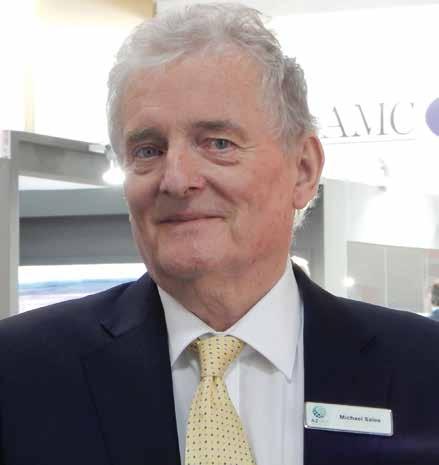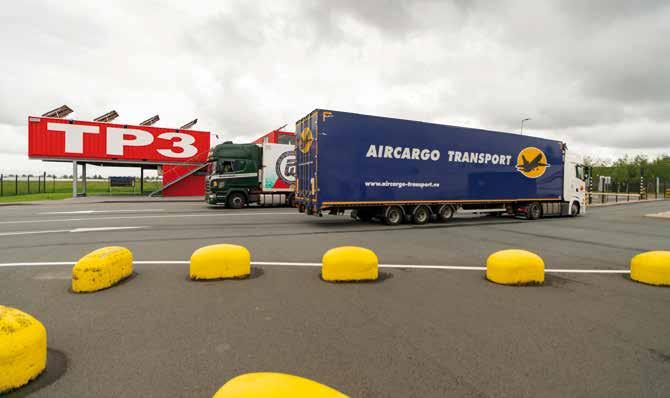
8 minute read
Learning communities in logistics
by Cargomedia
An instrument for innovation and learning
Life is continuous learning. A ‘rich’ and diverse learning environment contributes to actively being able to realise this. Young or old, student or professional. Learning is of all times and, to this end, the knowledge institutions should commit their education and research to the benefit of innovation and modernisation for business and government. The objective is to aim for a symbiosis in a so-called triple/quadruple helix setting.
Advertisement
Text Dr. Donald Ropes, Dr. Han van Kleef,
Dr. Richard de Jong and Drs Giovanni Douven, Research (Study) Group Learning and Development in Organisations, Inholland University of Applied Sciences
In order to remain competitive, logistics companies must constantly and continuously innovate. Increasingly there are also sustainability requirements from the customer as well as the local environment and the government. Furthermore, we are also seeing the complexity of logistical chains increasing ever further, which is an enormous challenge for structuring the associated logistical processes. The logistics professional with the requisite knowledge and skills plays a key role here to effectively contribute to the desired innovations. At ‘Topsector Logistiek’ we see that learning communities can be a way to ensure that companies work on innovation whilst, at the same time, investing in their human capital. The concept of learning communities was put forward by the top sectors in 2016 as a model for bridging learning, working and researching. Learning communities in the area of logistics are public-private partnerships in which stakeholders from companies, government and knowledge institutions work together on logistical challenges. The idea is that the learning communities’ stakeholders themselves are given the opportunity to innovate and in so doing the necessary knowledge, skills and experience becomes “theirs”, which raises the success rate of the innovation. Learning communities are therefore important for the lifelong development of employees but, more especially, are necessary for the specific and complex nature of many logistical innovations.
A learning-working environment does not come about by itself. Learning communities house a high level of complexity. This complexity comes from the task itself upon which is being worked, but also through the diversity – and various interests – of the many stakeholders involved. What it comes down to is that learning communities have to be cultivated and coordinated in a particular way otherwise they do not get off the ground, do not work well or they quickly disintegrate. The project Trucking CDM 2.0 is a triple helix, multi-disciplinary learning community, working actively with the establishment and structure of a digital platform to improve handling of air cargo. CDM stands for Collaborative Decision Making, the core of cooperative and collective decision taking. The project is a good example of what a learning community in logistics can achieve when developed and coordinated in a systematic manner.
Chain management is a central and complex subject for top sector logistics. Chain management around an interchange point or hub with varying stakeholders ensures even more specific challenges. Inholland University of Applied Sciences took up this issue with the Trucking CDM 1.0 project at the end of 2019 and since then has undertaken further research into the functioning and implementation of this Cross Chain Control Center (4C). In the period up to and including today approximately 15 students have been placed at various companies to ascertain if digital cooperation and deeper connectivity of company processes and systems can help in solving the somewhat structural and persistent problems of various stakeholders in the air cargo operations land side at Schiphol. With the Trucking CDM platform a breakthrough is at hand which will make it possible to generate significant improvements. An end to waiting, paperwork and lengthy lead times and ‘real-time’ detailed visibility of all freight parcels in the logistical air cargo chain. Through a three-year strategic collaboration with CargoHub and various parties in all links of the chain there is, via the continued development of Trucking CDM 2.0, continuity in research. We see that the latest technological developments have a place in this 4C IT data platform and that, step by step, the platform will be implemented further in the chain.
Learning communities are environments where innovation and learning can go hand in hand
With complex cross-company innovations involving many stakeholders a linear design approach is not possible. Intuitively, there is a view of a (possible solution) direction. But the interpretation of the innovation, the steps to be taken, learning, adjustments, follow up steps, etc, can only be done on the basis of continuously new insights, knowledge development and the experience gained by all of the involved parties. Together you rise to a higher level of collaboration and the innovation really works. This applies to the substantive development as well as the getting on board and retention of many concerned parties. This happens in a good way with the Trucking CDM. This approach is called effectuation: begin with an idea with existing resources and partners, and then through research and trialling, often intuitively, develop new solutions to find additional resources and partners. In order for the idea of a 4C such as Trucking CDM to crystallise substantively, there needs to be ever more interested parties interested in development and implementation.
In a learning community learning processes take shape when hunches, ideas, nuances, information and knowledge are shared by participants with each other and then combined in new ways. A condition for learning and innovating in this way is that participants must be able to discuss, negotiate, confer and work together. This calls for specific competencies from the leadership such as: networking skills, a neutral stance, an ability to communicate with other cultures, listening skills and an ability for democratic decision-making. Practical experience in the field of innovation is necessary to be able to effectively lead innovation projects.
Critical success factors (CSF) for learning communities
Successful learning communities are set up in accordance with a plan based upon a number of critical success factors. We can split these factors into four themes: 1. Content 2. Structure 3. Processes 4. Culture
1. Content Content in a learning community relates to the integral question as to what everyone is occupied with. This forms the basis of the CSF’s ‘common interests’. An element of urgency must also be felt by all parties. This is a secondary CSF.
When working on a complex question (for example in the area of sustainability) it is precisely the factors ‘common interests’ and ‘urgency’ that exert additional pressure. In the Trucking CDM project we see that the parties in the chain handling air cargo almost all experience the same set of problems: long waiting times, lengthy throughput times, still lots of manual paperwork and little insight into processes and status within the chain. At the same time, increasing demands for sustainability are being stipulated. There is therefore talk of a common goal around improving services and products. An IT platform will have to add value to the tasking of the individual, the section and the affiliated companies. “Alongside lower costs and higher revenues in the monetary sense, the IT data platform can also contribute on other levels such as improved customer service, more sustainable logistics, a more robust and resilient chain, creating logistical opportunities, anchoring industrial activity, cluster effects and societal benefits.” (Eric Brouwers, ProSales and Bart Vannieuwenhuyse, TRI-VIZOR).
2. Structure The structure of a learning community has to ensure an efficient exchange of knowledge and information between the stakeholders. The management of a learning community has here a facilitating function. The development of the IT platform takes place at a central organisation, CargoHub. The broader application however cannot be driven, let alone enforced, by this organisation. On the basis of pilots undertaken by a large number of involved parties in the chain, increasingly new functionality is being tested and a base is being laid not only for further development of IT functionality, but also for further implementation of the IT data platform. Success of a 4C is viable provided that the leadership and organisation of the collaboration is foreseen with sound management. 3. Processes The objectives for innovation and for more sustainable solutions, call for processes that share ideas, knowledge and information. It is necessary for there to be room for collaborative processes exploring, studying, experimenting, negotiating, decisiontaking, monitoring and evaluating. A qualitative good implementation building mutual trust and a common culture requires regular meetings of sufficient length under professional supervision. There can be room herein for the earlier mentioned effectuation, for example, discussion of the pilots, but also evaluation and reflection upon the conditions for success.
The processes and the associated organisation merit both a neutral character and maximum transparency. An extra element of a 4C around a hub is security: data security but also securing the physical goods processes. Intensive cooperation with appropriate specialists can be helpful with this.
4. Culture As a result of an open secure culture having been created stakeholders dare to experiment. Where a laboratory-style atmosphere can be simulated to optimise logistical processes further, state-of-the-art tools can be tried out. At the same time, it needs to be an environment where people feel at home and where achievements are positively rewarded. A climate where mistakes fall onto fertile soil to be subsequently taken up into the learning curve towards higher aspirational levels.
In this piece we see that ambitions for optimisation and sustainable development generate complex questions. The development of innovative, useful solutions for these questions succeeds only if stakeholders are prepared to come together in a learning community that meets the critical success factors outlined above. Trucking CDM 2.0 is an inspiring example of such a learning community under development.










